As the day was ending, and the sun sinking into the west, I looked up and saw a rainbow patch in the sky directly above the sun... Quickly grabbing the camera, and stepping outside, so I had a bushy tree between me and the sun I grabbed a couple of quick shots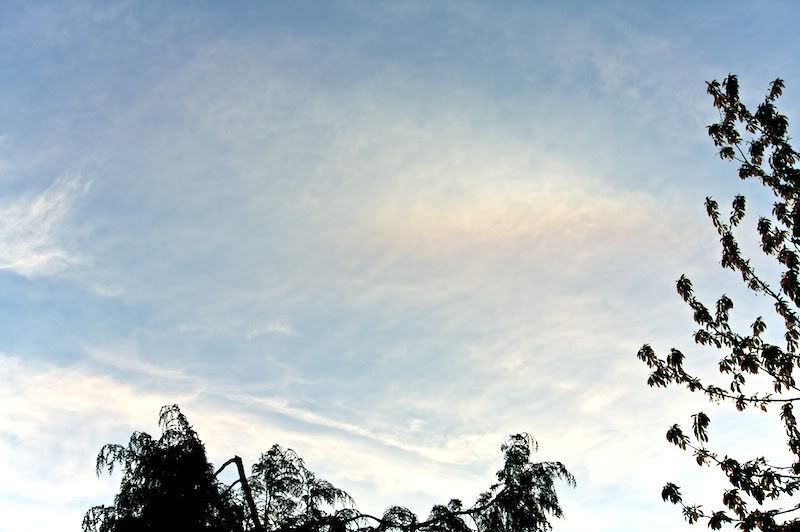
and with a plane
these have been ID'ed to me as Upper Tangent Arc's, first time I've caught something like this on camera.
I kept an eye out as night fell, to see what the conditions would do, there was some high thin mist again, and my back was worse than normal, so I didn't get out the HEQ5. I did set the Skymax on the camera tripod for a couple of shots at the moon
Another Horns shot
And a normal angled one
Next up was the first flare of the night. I setup the Satcatcher, with the 450d and EF 50 mm lens mounted ready, and watched the clock tick away, and caught it
Iridium 12 - Mag -2
Then, with an hour and a half before the next flare, I setup the little NexStar (much easier to move about as it's so much lighter) with the Skymax on it and had a bash at some more webcam work.
Firstly a wide view using only the webcam of the region I was aiming at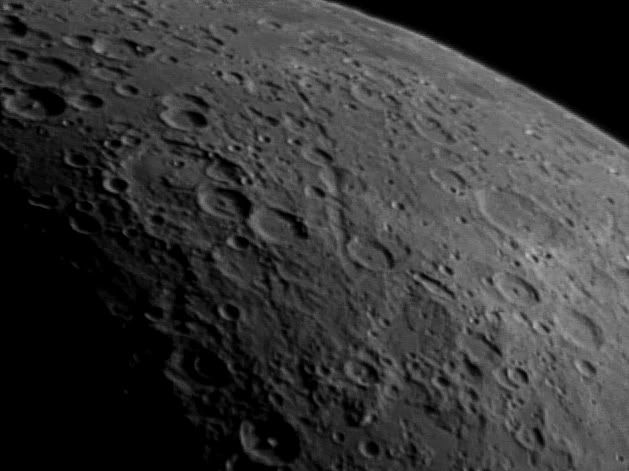
Then a couple of closeups with the Ultima x2 barlow as well...
Piccolomini - I'm not sure why this has come out so noisy.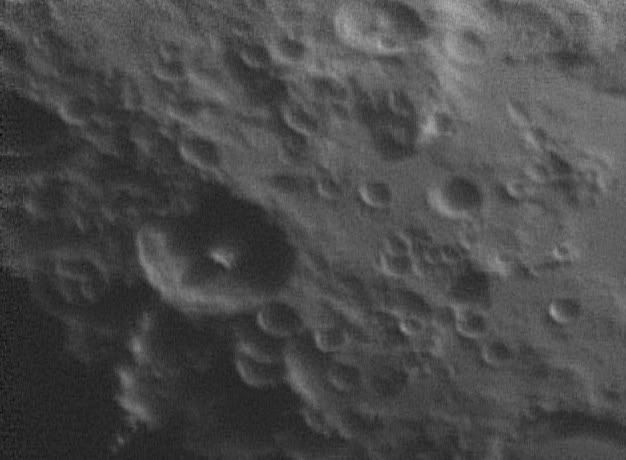
Jannsen itself, I pushed the frame rate up to 15 fps for this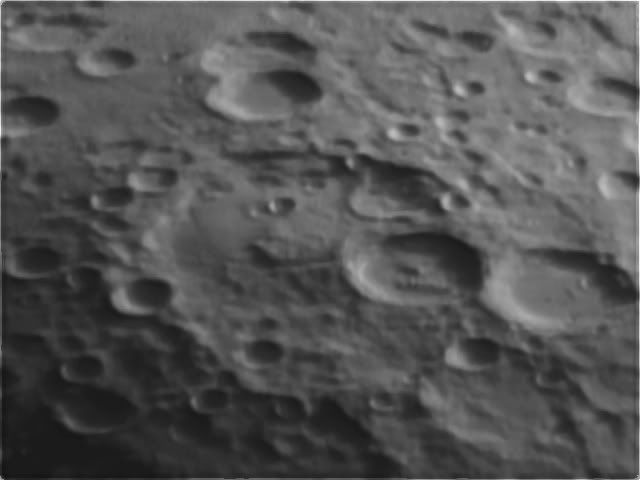
I packed up at that point, and waited for the next couple of flares to come along...
Iridium 62 - Mag 0 plus a plane over my neighbours house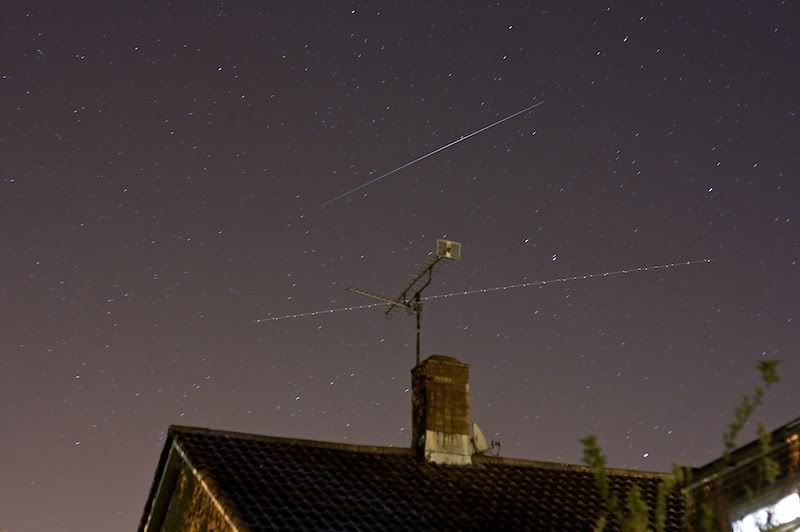
And finally Iridium 57 - Mag -7, I didn't give myself enough time to line this up and it was a bit rushed
It was good to see a few flares and image them again. I enjoyed that, it's good to get out even with limited facilities.
Wednesday, 29 April 2009
Halo, Moon and Flare
On the horns of the moon
A lovely crescent moon was riding the sky last night, and thankfully the predicted severe weather didn't materialise. There was mist high in the sky, so I didn't bother with attempting any deep sky imaging, and went for the moon instead. I put the Skymax outside for 30 minutes to acclimate before taking the HEQ5 out. The moon was low enough by this point, that I had to put the mount on the decking (a really poor choice of surface, as it bounces a lot) to be able to get an angle on it, thanks to the tall trees at the end of my neighbours garden. Still I figured I'd get an hour and decided I'd go for a mosaic using my webcam. So after levelling, polar aligning and balancing I got going.
This is a 10 pane mosaic using the SPC900, each pane was about 650 frames, stacked and processed using Registax, merged in iMerge and tweaked in GIMP.
Click for bigger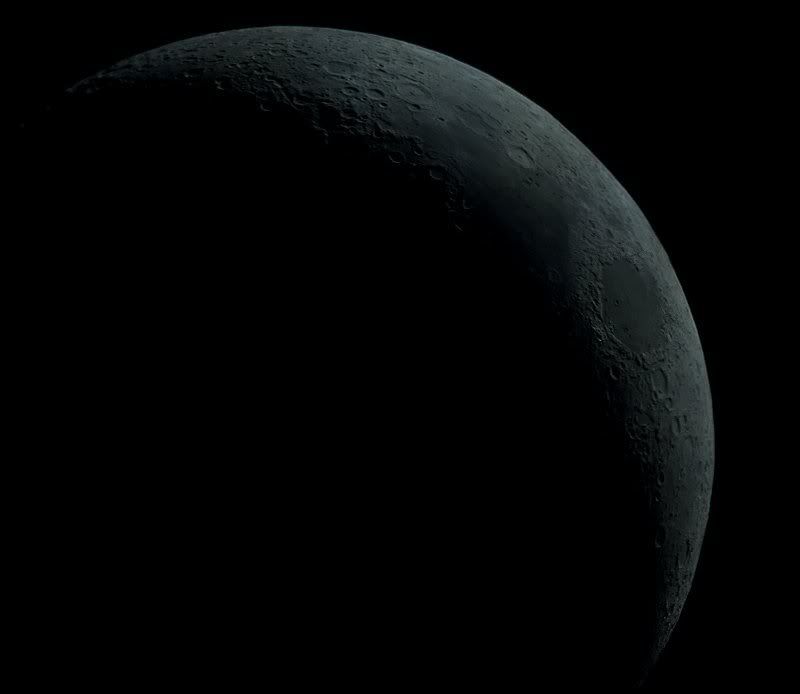
I also got an AVI of Saturn. It's not great, I've still got to work out the settings on the webcam properly, but this was using the Ultima x2 barlow.
800 of 1800 frames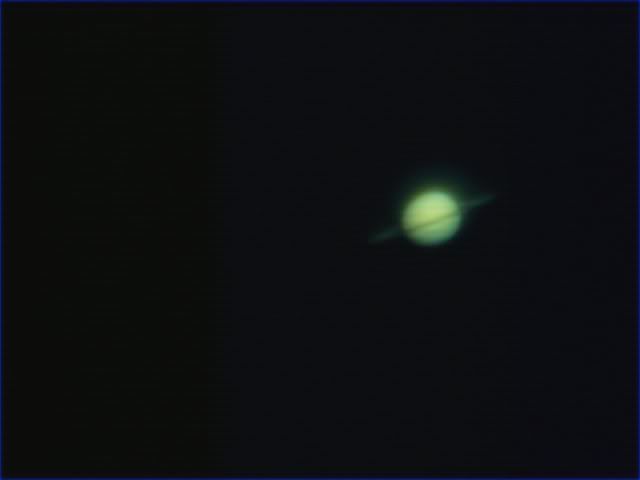
As I was packing away, I left the Skymax outside for one last shot using the 450d at prime, and angled the camera to get this
I'd already checked and there was a flare (Iridium 21) predicted for about 20 minutes later, so I set up the Satcatcher and the 450d with the EF 50mm lens. Having made some modifications with different mounting plates (I have the same mounting plates and adapters on all my gear now, it makes swapping the camera about a lot easier) I need to tweak the configuration and may need to use a longer piece of wood as the compass wasn't pointing accurately. And to top things off, the clouds were moving in. So this was shot through the clouds, although, not the brightest of flares at Mag 0, it was still bright enough to cut through the clouds.
Tuesday, 28 April 2009
Only the moon
Not much doing last night with the skies except for plenty of cloud. I did manage to get a shot of the moon in the gap that appeared last night. I could see if coming, so I popped the skymax on a camera tripod, and put it out to cool... 450d on the back. My first shot was a bit overexposed, and it was clear from that there was quite a bit of mist up high even in the gap I was using...
Monday, 27 April 2009
Diana and Hermes
After a clear and lovely day, there were hints of clouds off in the east and south, but I'd seen hints that Mercury would have a pointer in the young moon with the Seven Sisters just above. So I got out after the sun had sunk below the horizon and went hunting. I used the 10x50's and after a few minutes found the moon, but the sky was still to bright to find the faint dot of Mercury. I left it a little while, gambling that the clouds would hold away, went back about 15 minutes later, and there, a little below the moon was the innermost planet. It took a little while longer, but as the sky darkened I was able to see Mercury with the naked eye.
I grabbed the camera, on the redsnapper, and using the 55-250 caught a few shots.
With a plane that moved quite a way during the exposure 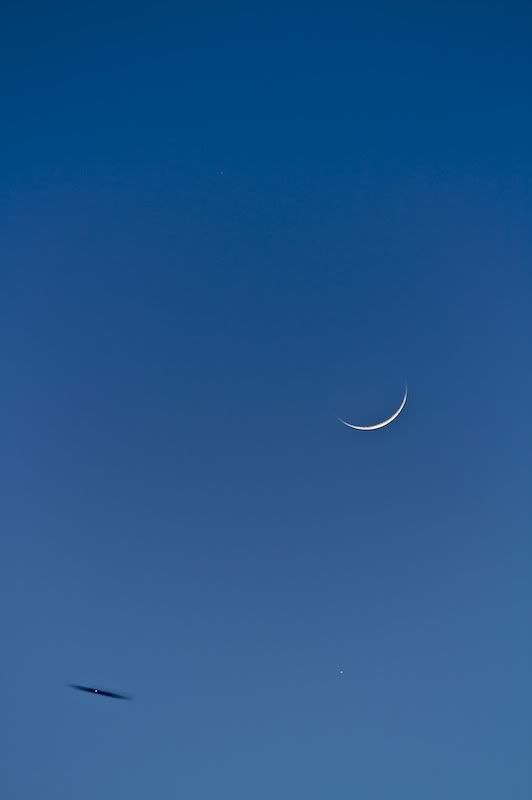
A couple of different variations with clouds

Any my favourite, I saw a big bank of cloud moving in, and waited until it partially filled the frame, threatening the Moon and Mercury and caught this
The clouds moved in with a vengeance after that. I'm glad I got to see Mercury at last, I've been trying for quite some time now. I have now seen all the planets from Saturn inwards.
Sunday, 26 April 2009
Planets, Sharing and nothing doing - Addendum
I forgot to add it to the entry, but I worked out why the goto slew was all out by the same amount on each one... I PA'ed on BST, not UT, not the first time I've done it, and I doubt it'll be the last. I think it's time for a check list in big letters...
Planets, Sharing and nothing doing
The forecast was wrong again... odd that. So as the evening wore on the skies cleared. Enough so that I could actually see the skies in the west. I tried to find Mercury, both unaided and with the 10x50s. I even went as far as to pop the bins on the satcatcher and use that to get them pointed at the right spot. Nothing doing. Not a shine of the elusive little winged one.
Anyway, a little later, and with friends over, I was asked to setup the scope for a look at Saturn. I grabbed the Skymax on the NexStar, a great little combination for this sort of thing, levelled, aligned on Saturn, and tried a number of EP combinations. I ended up using the 5mm Hyperion, which for proper observing, giving x260, is a little OTT given the 102mm aperture, but for showing someone who's not looking for proper observing, the view was fine. Even to the point of seeing a moon or two. After everyone had taken their turn at the ep, I had another look, and cleared up. Putting the power pack back on charge.
About an hour later, the sky still being clear, I grabbed the Guided setup and went out for an imaging session. I'd decided to have a go at the S@N imaging challenge, to capture Markarians chain with about 200-400mm. I setup the camera piggy backed on the Konus, focused using Saturn. I put the Meade DSI on the C80ED with the intention of attmepting to use it for imaging, and tried the SPC900 on the Konus for guiding, in theory, PHD is able to use a normal webcam by stakcing frames on the fly. Well, suffice to say things were not to be. I had to add the second weight to get balanced. The Goto align didn't want to play ball, and no matter what I did everything was out a little (It's just this minute occurred to me why DOH!!!) I spent ages trying to get the SPC900 and the Meade focused, only to find that no matter what I did, I couldn't get PHD to find a star at all with the SPC900. I then tried to guide using the Meade on the C80ED, and for the first few attempts, PHD threw errors saying it couldn't talk to the mount. I ended up having to close PHD and start again. Then PHD calibrated ok and it sort of worked in that not quite kind of way for about 2 minutes... throwing Low SNR errors and losing the star a little afterwards.
I then moved the Meade back to the Vista, and again had to refocus, I finally managed to do this, went off to try again, set the camera running, checked the frame capture and no stars at all. The objective lens had dewed up. No dew shield on the camera lens. The scopes objectives were much better, but even they were beginning to dew up. I decided enough was enough, slewed around to Saturn again, put the camera back on the C80ED, sorted out focus, packed up and came in. Now to warm up.
Showing everyone Saturn and a moon was great, but I got frustrated with everything else, so largely one of those nights. Better luck next time.
Thursday, 23 April 2009
A poke in the eye addendum
I've noticed that I made a bit of a mental miscalculation when I posted this, and indicated that the sub lengths were 20 minutes each, they weren't they were 10 minutes each, and I've mistyped it on the images too, that I can't change easily.
A poke in the eye
My plan for tonight, another clear night, the fifth in a row... (is this a record ?) was to have a go at a widefield image of Leo using the Nifty Fifty piggy backed on the scopes. A couple of problems with this. The angles were all wrong to fit Leo in the FOV, and the mount wouldn't balance in either axis. I may invest in a small ballhead and mount that on the piggy back screw to allow more flexibility in camera positioning.
So having decided that was a non starter, having already PA'ed, I grabbed all the wires and the lappy, hooked everything together, ran a quick 3 star align, thinking initially to have a go at the Leo Triplet and add some time to my previous image, but changed my mind, and thus my alignment stars and went for M64, the Black eyed galaxy instead.
Having read something on SGL about a method for removing horizontal banding, I had a plan. I set guiding running, set the camera for 10 minute exposures and to capture 6 of them. Then set a countdown timer to go off after an hour. The intention being that I would rotate the camera a little in the focuser, capture another hour etc. I noticed, however, that after only four subs, PHD was having a fit about low SNR, and clouds had moved in. They looked heavy enough for a spot of rain, so I grabbed some flats, and whilst clearing up, grabbed a few darks. I'm not sure I'm going to use them yet though.
This is 4x600s @ ISO800, with 3 flats. 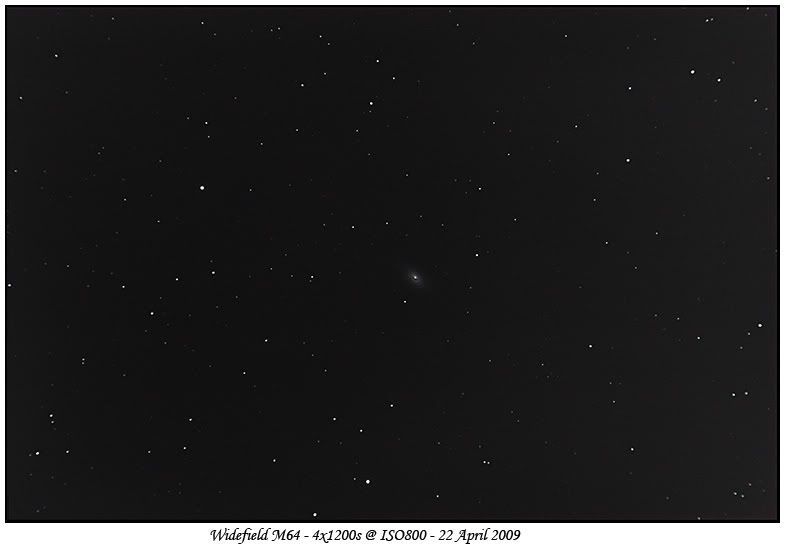
and a crop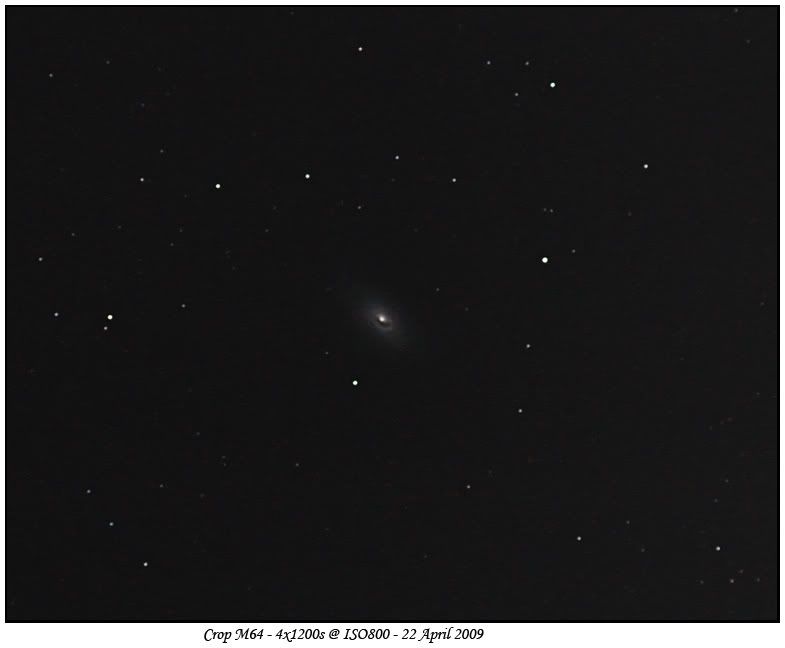
I have to say, that I'm not sure I'm going to bother getting more data at the moment, whilst you can tell what it is, it's too small for my frac to do justice to, there's just not enough sensor coverage for any decent amount of detail to show through. Time to find another target I think.
Of course, within 40 minutes of clearing up, the clouds had moved on and the sky was clear again. Ho hum.
Wednesday, 22 April 2009
NGC4088 and the Supernova
I decided to have a try at capturing the Supernova last night. So I setup the EQMOD goto features and it positioned the galaxy spot on in the middle of the sensor.
My first attempts at processing this had all sorts of oddities in the background
12x 360s @ ISO800, no darks, 9 flats, and bias
450d on C80ED
Guided by Meade DSI1C on Vista 80s with PHD
Stacked in DSS
Mucked about with in PS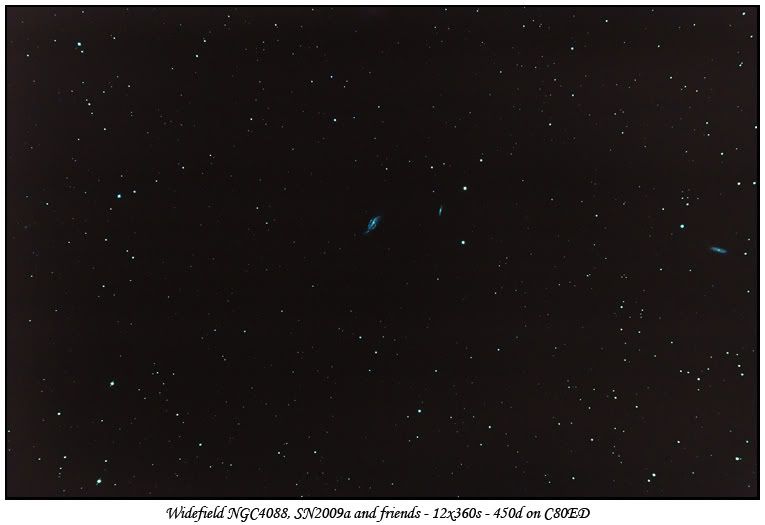
and a crop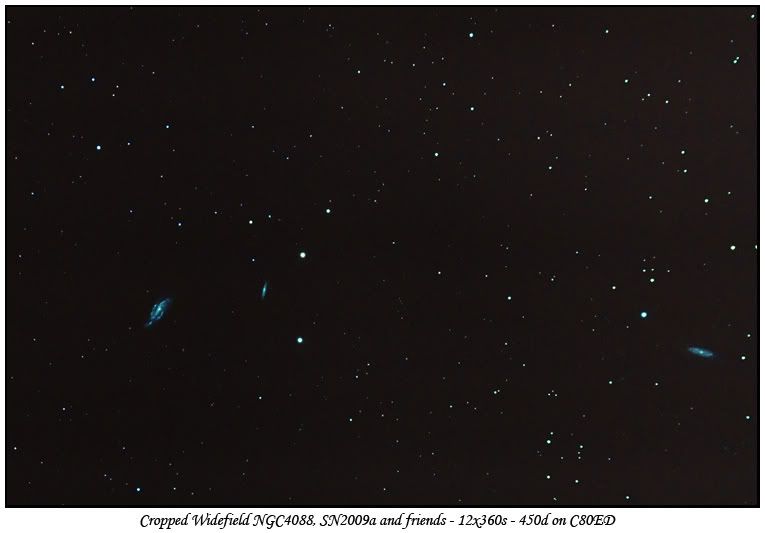
So I grabbed some darks, and added them into the mix, but that only made the image worse, and I didn't bother to save it.
I had a restack, threw out all the darks and bias frames, and most of the flats too... It looked much better, I wish there was some logic to all this....
12x360s @ISO800, 450d on C80ED
3 flats
Guided using a Meade DSI1C on Vista 80S with PHD
Click for bigger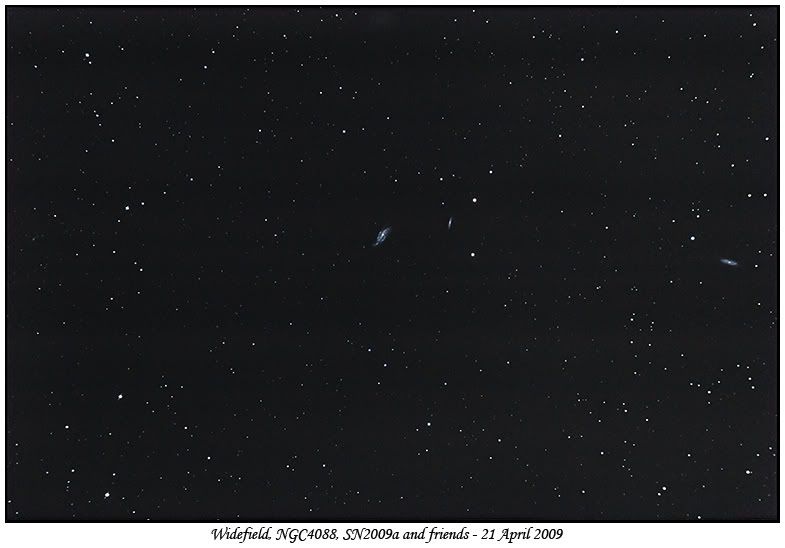
and a crop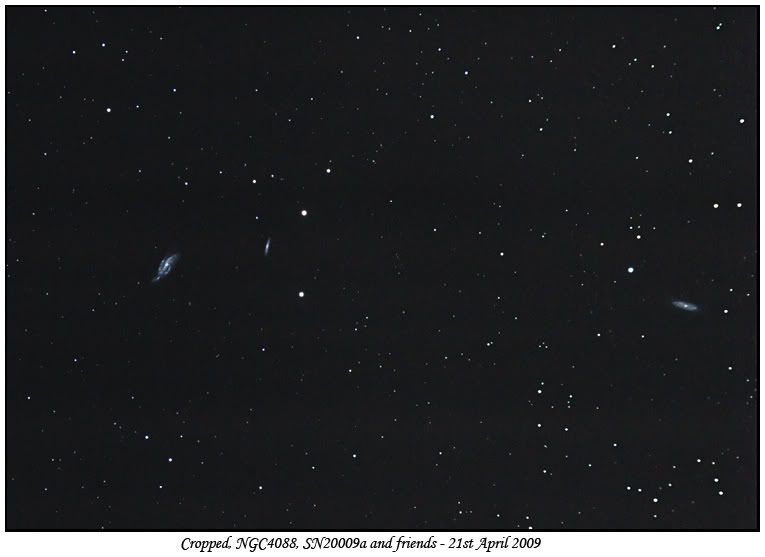
After that, with power running low on all the components, the lock gone, thanks to the meridian flip, I gave up, packed up and came in. I'm very pleased with the second set of images.
EQMOD
I have but one thing to say...
EQMOD Rocks
After I got the HEQ5, I started investigating guiding options and checking out costs. Well, It turned out, that the USB-TTL cable was by far the cheapest and offered the most capability. So I took the plunge and ordered one. I also ordered a Cat5 flylead so I could but the end off and finish the cable to the mount. After some mildly scary, well it felt like it to me, plugging it in, and powering up all the components (I didn't want to fry the mount cos I'd messed up the wiring) all worked perfectly.
So, over the past few days, well nights, I've been completing the setup.
On Saturday, with the cable still not 100% complete, the wires are not held together tightly as yet, I went out to test the rig. My first attempt at guiding worked perfectly using PHD, and leaving EQMOD and ASCOM on the default settings. Ok I had some issues, but that was down to inaccurate focus on the guide scope (easily solved).
On Sunday, I tested out full guiding, and was able to take 20 minute subs, although the first one felt like hours as I was waiting for the capture to finish. One thing I did find, that to adjust the alignment, given the Syntrek handset is no longer attached was quite a faff as I had to use the lappy touchpad to make positioning adjustments.
So on Monday, I hooked up an old logitech gamepad, set that up for EQMOAD/ASCOM control, and on testing found that, whilst I have a small issue with the joystick contacts in the gamepad (I need to look into this, possibly literally), it works perfectly, and I was able to adjust the position of the scope from where I needed to be, so much easier.
Then yesterday, I setup the Satellite tracker control program. I've got all the communications working, which was the hardest part. The SatTracker program is designed for Meade and Celestron mounts, so needs a couple of additional modules installed to enable comms to the HEQ5. EQMOD talks to the mount, and is controlled by EQMOD/LX which is a protocol converter from Meade LX200 speak to ASCOM speak. As this is talked to by an IP connect, and the SatTracker software only talks to a com port, a piece of virtual comm port software is required to redirect the com port contriol signals to the IP socket... Eventually I got that all setup right, signed up to Space-track, and in theory it's good to go. I've yet to test out this component.
Then last night I setup the Goto and CdC integration. Very easy to setup. CdC already talks EQMOD/ASCOM, so within the EQMOD app, click N Star Align, back to CdC, select an alignment star and tell CdC to control the mount to it, align with the gamepad, click align in EQMOD, and repeat. After doing a 3 star align on Alkaid, Denebola and Dubhe, I used the Goto to take me to NGC4088, my target from last night, and NGC4088 landed smack bang in the middle of the FOV as my image from last night will attest, I didn't adjust the position in anyway.
And then one last thing I found last night, as the mount tracked up to the zenith and hit the meridian flipover, I was keeping a close eye on it to prevent accidents. EQMOD prevented the mount moving further (and prevented PHD forcing the mount to continue, then after a few minutes, forced the mount to Park.
The total setup time, from carting out the mount and scope, to being on target and guiding (and I had to work out how to setup and align the goto so it should be less next time around) was 25 minutes...
Brilliant, and all the software is free. The cabling cost me about £20 and some nervousness. I'm happy and really impressed with the ease of use.
Tuesday, 21 April 2009
M51 reprocessed and NGC4088 + SN2009a
I had a restack of my M51 data yesterday, at the suggestion from a couple of people on SGL, without the darks I'd taken. The results I found astonishing. The image was easier to process, less noisy and had more faint detail revealed. The connection between the two galaxies is now clear and the tail can also be seen (ok they're dim and probably more data will help with that, also if you look closely, there are a couple of dim fuzzies above and to the right that couldn't be seen in my original stack.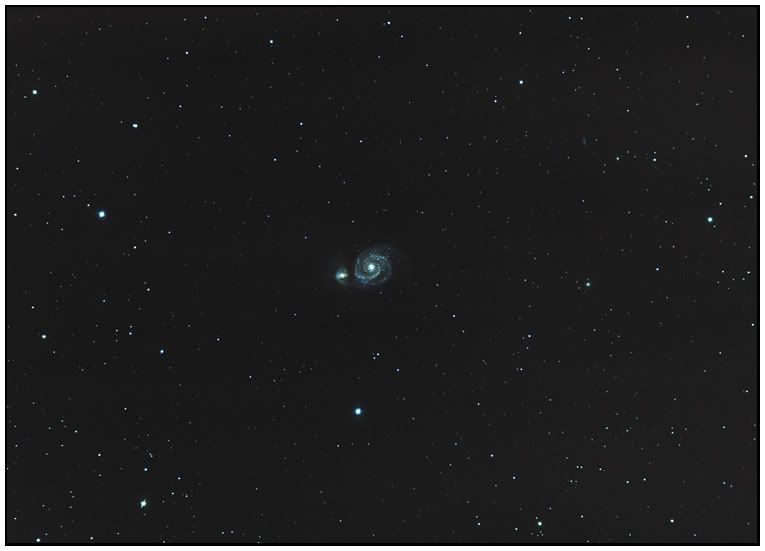
And I found I could crop in on this without too much bother, as the noise was less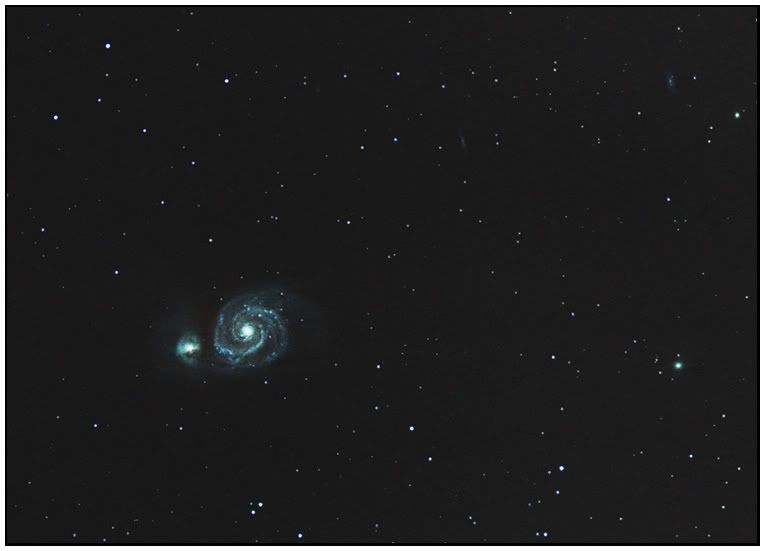
I wonder what the criteria is for requiring darks... I know I don't get any issues with ampglow, and the DSS process can deal with hot pixels without the darks. This is going to take some experimenting.
And onto last night. I got EQMOD fully working now, but I'll write that up seperately as there's more to it. Suffice to say, I used the EQMOD goto and landed NGC4088 bang in the middle of the chip without having to reposition. I captured 12 x 6 minute useable subs, and here's the results without darks.
and cropped
the background isn't as nice, and the stack had a green tint to it. This needs some more work and probably a restack. Still it was good to get, and you can see the supernova in the heart of NGC4088 to.
Adding more time to M51
Another clear night, so I setup again. I'm working on streamlining the setup process, and I've managed to get the entire thing, from deciding to setup, to starting capturing the first full image to under 25 minutes. That's cart out all the gear, level, polar align and fit all the bits together. Wire up the lappy, I added a game controller yesterday, more on that shortly, manually slew to a nice bright star, that way I can set the PHD loop time to very low, and the calibration is over and done in short order. Slew to my target, M51 again, take a series of framing shots and adjust the mount, engage guiding and away.
The game controller, talks to ASCOM and allows me to control the scope position, in the same way the ASCOM control buttons do, but instead of having to mess about with the lappy, I can just move the joystick, much easier. Next up, will be to sort out the Goto features of ASCOM, although I may wait till I'm properly powered. With guiding running my powertank is only good for about 2.5 hours.
Anyway, I captured a series of 11 x 10 minutes exposures @ ISO800 and added it to my previous nights 20 minute exposures. After staking in DSS and pulling and pushing in PS, this is the result.
It's an improvement, there's a bit more in there, not as much as I thought there might be though. I may well have another go, next clear night and see what happens with 15 minute ISO800 subs.
Sunday, 19 April 2009
Full Moon and getting going with guiding
I managed to get a shot of the nearly full moon, I can't believe I didn't post these. They aren't the best, it's tricky with no contrast to focus on. It also turns out that my little skymax has some collimation issues I need to sort out but I'll come to that in a mo.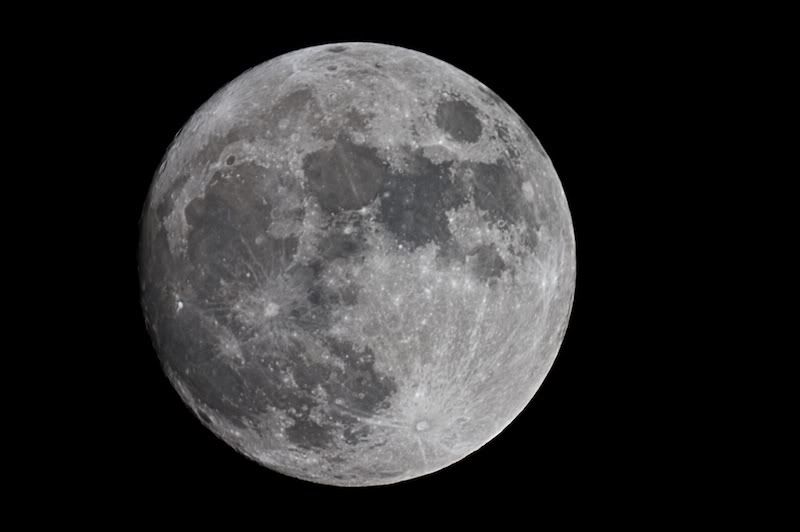
and some colour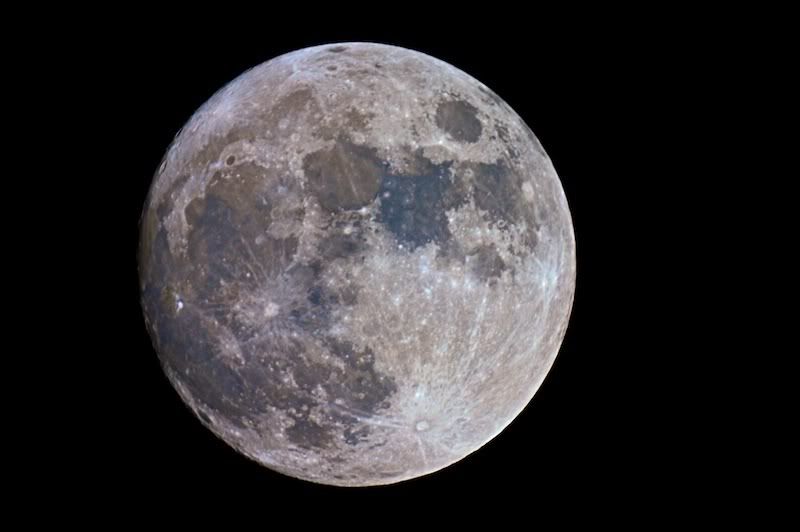
About a week later, and more clear skies. I decided to have a go at M51 using the Skymax. During focusing of the 450d, at the 10x magnification I noticed that the out of focus ring patterns were not circular, so this means the collimation is out. I setup in the normal way and, using the 450d, started capturing data. For some reason, and I think it's down to a combination of things, trailing being the biggest, the 2 minute subs won't stack, but here's a single image frame
Anyway, after nearly another week, some more clear skies, and this time, feeling brave, I decided to try out guiding. A little while back, I bought a USBTTL cable from FTDI and fitted the end of a Cat 5 LAN cable to it. I'd tested this with EQMOD for mount control, and was able to control the movement of the scope with it.
I setup the lappy with all the cables plugged in, attempted to focus my Konus guidescope as best as I could, using PHD and the DSI1C, aligned the scopes on Regulus (it's good and bright), set PHD to guiding. The first attempt failed as there wasn't enough motion from PHD. I remembered a mention in a lecture given by Nik Szymanek about this, and found the right setting. It was too low for the little 400mm Konus, so I increased it and tried again. This time it worked perfectly, and within a few minutes PHD told me it was guiding. I set the 450d to capture a single 10 minute sub and waited.
Some time later.. (well only 10 minutes, but it felt like an age...) the camera stopped and I went to check. All the stars were spot on, no problems at all.
I swung the scope around to the M51 area (I'm not using the slewing motors as yet, it'll go through my limited power supply in too short a time, that's for mains power). Took a test shot, tweaked the aim until I was happy, setup for guiding again, although there aren't any bright stars around there, and it took a little tweaking to get it running. Set the camera to 20 minutes, I wanted to see what was possible, and set it off. After only a few minutes, PHD was complaining that the guidestar had been lost. Damn. Clicked stop and guide again, hoping that it hadn't been for too long a period and left it. Well this carried on, and after the third attempted sub, I had a more thorough look at things. I found that the Meade software contains a focus enhancement tool, and I used this to tweak the focus. I'd just for it to as high a value as possible when the mount ran out of power. Ah well, a bunch of wasted subs, but some useful knowledge gained.
Then tonight, only one night later, and again it's clear. This time, armed with my knew knowledge, and already tweaked focus (although I did check it as I'd moved the mount and scopes in) I set out to try again. This time, despite the skies looking somewhat damp, I had no problems locking a guidestar and keeping it locked. I set the camera off for 20 minutes again, and let it run.
After some time, the mount power was running out, I'd only caught 5 frames, and I'd been hoping for 6 (ah well) and all 5 were showing as spot on. I also spotted that the screen on PHD was looking odd. As I was done anyway, I stopped PHD and had a look at the objectives. The Konus was heavily dewed up, the C80ED much less so. I can only conclude that this is the difference in the dew shields. I guess the next purchase is going to be dew control, hmmm, I'll need more power for that too...
I grabbed some darks and flats... The darks are going to be scaled, there's no way I'm waiting an hour to get 3 darks.
After stacking and processing, this is the end result.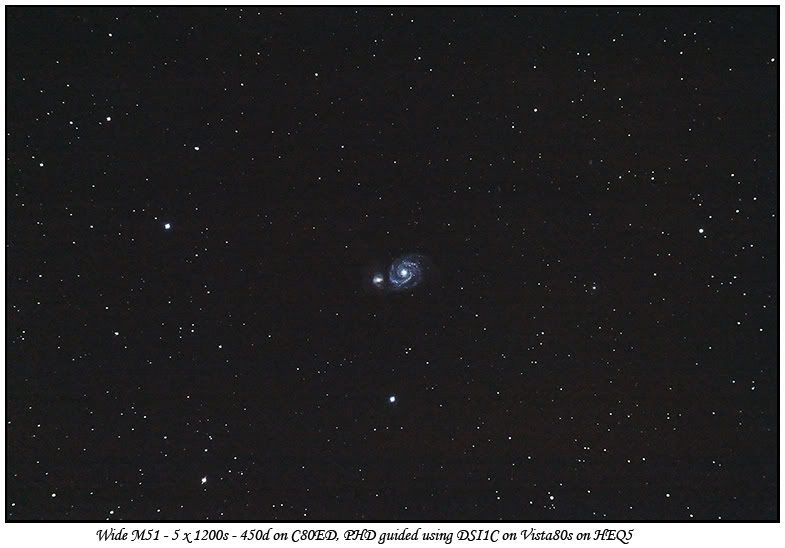
I had to do some heavy duty noise reduction, but as I only got 5 subs .. I'm happy and looking forward to being able to grab a bunch of 10 minutes at ISO 800 to add to this.
Tuesday, 7 April 2009
Saturday Night's Moon
Just a single Moon shot, the sky clouded over soon after and hasn't been clear since.
The Skymax 102 on a camera tripod with the 450d at prime
And with a little colour lifted up
Saturday, 4 April 2009
Another Moon and some lunar surface mosaicing
I managed to get out again on Thursday night. First off to grab another shot of the moon with the 450d on the Skymax, tripod mounted
I also pulled up the colour a little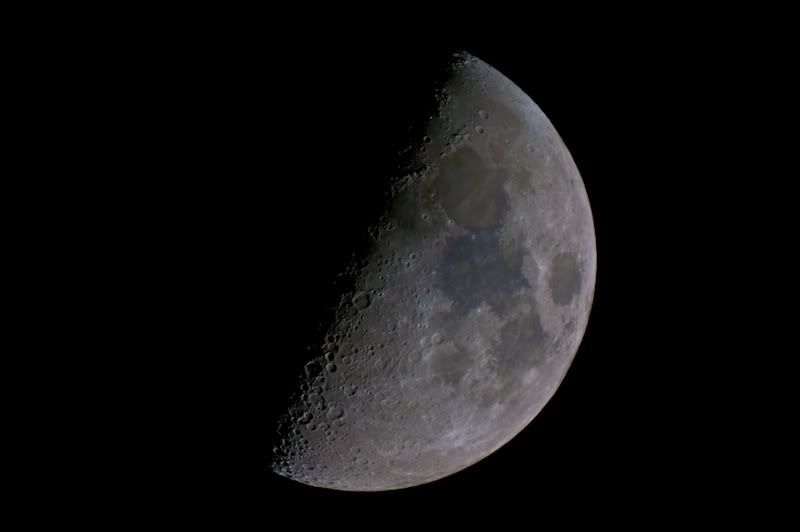
I then setup the Skymax on the HEQ5 and tested out what I thought would make a good planetary/lunar camera, the aGent V4. It's a very nice webcam, and supports high frame rates etc, but the lack of a gain control in software makes it unusable for Astro. So I used the SPC900 to capture some close in shots. I had a bash with the Ultima barlow to start with, but I'm having real problems stacking the image. This is the best I've come up with, but there's something not right with it. I suspect it's down to tracking issues at the high magnification involved.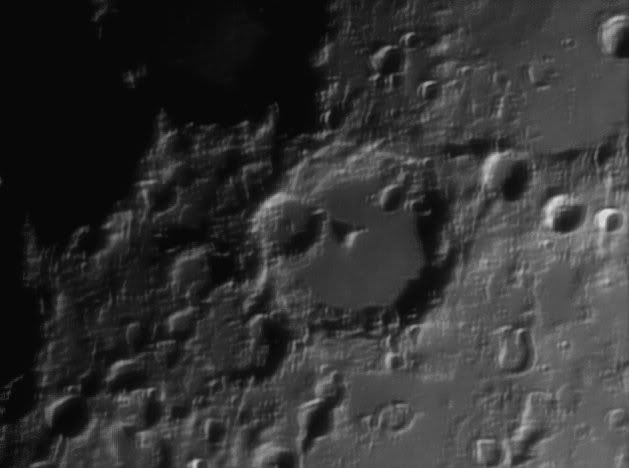
I popped the SLR back on with a 2x TC and had a bash at a small three pane mosaic, firing off 20 frames for each pane, then stacking in Registax and mosaicing in imerge.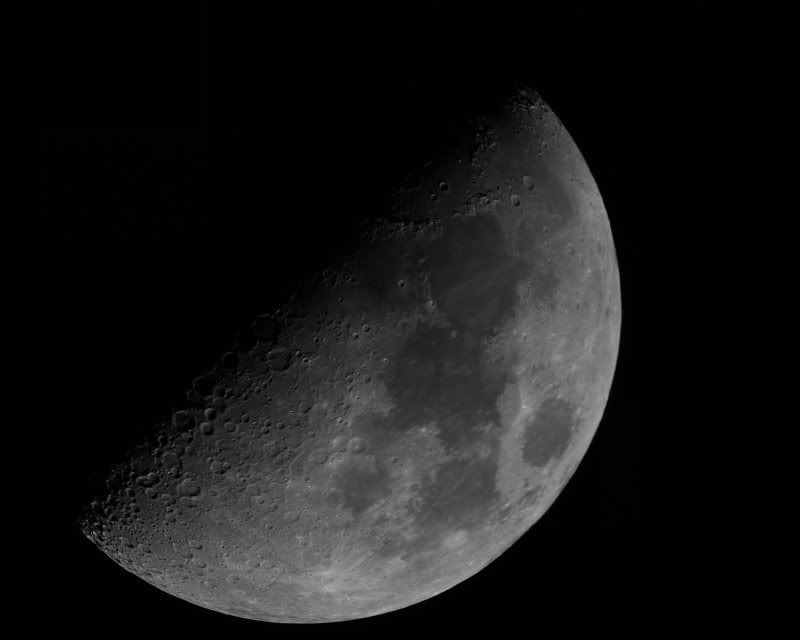
I then thought, as I hadn't done one yet, I'd have a go at a terminator mosaic. So 9 AVI's of about 1200 frames, registax processed about 1000 of each, and mosaiced in imerge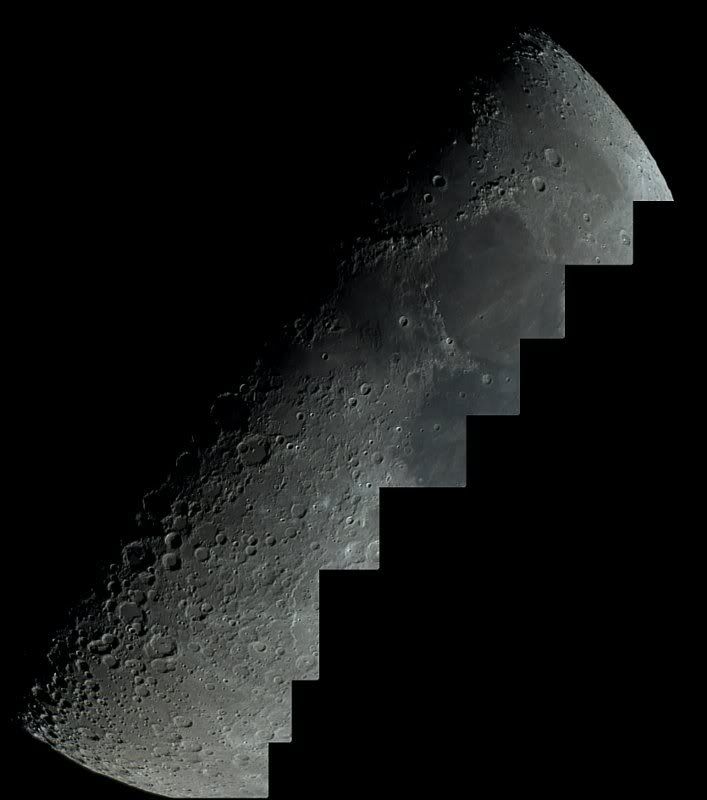
As I was in the groove and capturing well, I had a bash at a full mosaic. I hadn't thought anything about doing this, so it was a bit of a suck it and see approach to capturing each pane. This is 18 panes details as for the terminator mosaic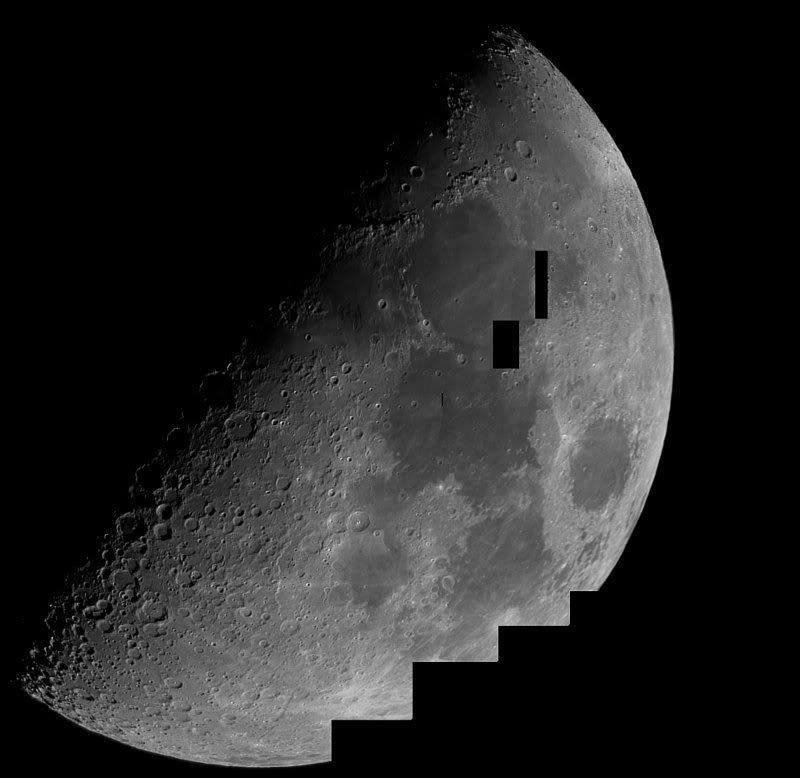
As you can see, I appear to have missed a few bits. I need to work out a more methodical approach to capturing the data. I will have another go at this.
I then had a bash at Saturn using a 5x barlow and seperatly the 2x barlow, but the AVI's won't stack and to behonest they were a bit (well a lot) rubbish. I think, partly, this was down to dewing up of the corrector so I will be making a dew shield out of some camping mat.
The HEQ5 works really well for this, the Skymax is such a small little scope, it looks a bit like a toy, but it works very well. Oddly, I find the focuser on the Skymax easier to use than the focuser on the C80ED. A fun session.
Thursday, 2 April 2009
The Moon, Day's 5 and 6 and More data for M81/82
I managed to grab a shot of the moon with the Skymax in a hole in the cloud for day 5, the image isn't great, the scope didn't have time to cool down, and that is important, it was also a bit rushed thanks to the clouds buzzing around, but I got it.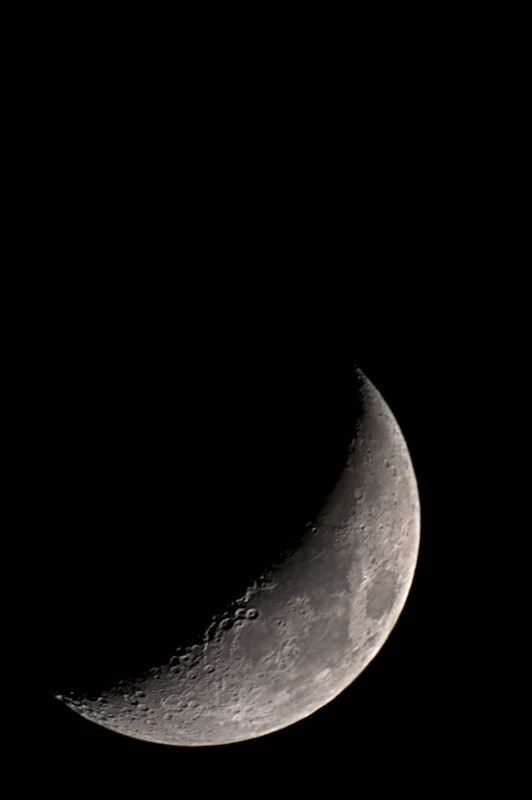
Then today has been lovely clear blue skies, with the odd whisp of cloud drifting through. Only to clear completely just after sunset. This time I allowed the Skymax to cool, even though it's near ambient anyway as it's kept in the garage, and I could tell the difference straight away, even through the camera Viewfinder.
I lifted up the colour also.
I had been concerned that perhaps the Skymax needed collimating, and was going to try a startest, I will at some point, but I think these images indicate that it's actually ok.
Then I setup the rig for some more time on M81/M82. By using the 24x80 finder scope, I spent a lot less time faffing trying to find them, so have got a lot more time imaging. Although, for some reason, I seem to be only able to get 2 minute exposures, whereas I was getting 3 last time out. Actually thinking back on it, I may know why. When I setup the HEQ5's polarscope I set it up using GMT. My watch, now being on BST is one hour ahead of GMT. I used my watch time, not GMT for the setting circles on the polarscope, so I guess that the Polar Alignment was a little out. Must remember that one.
So after running for nearly 3 hours, I got another load of 2 minute subs. Stacking in DSS, which threw one away, I ended up with 168 subs stacked, 134 x 2 minutes and 34 x 3 minutes, with 63 darks, 63 flats and bias frames, then stretched and processed in PS.
I'm really pleased with the result, and I don't think there is any benefit in going further, at least until I get guiding working that is.
Now, I've got to work out what to do next.






